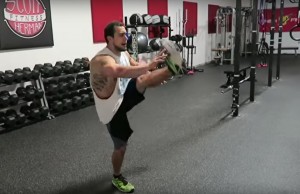 Ever since junior high school PE class, the importance of stretching before exercise has been drilled into our heads. Some instructors say it’s to warm-up your muscles and get blood flowing while others say it’s to improve muscle elasticity and range of motion, and some will tell you stretching does both for the ultimate goal of avoiding injury. If you’ve gone through life adhering to the pre-workout stretching rule, you probably feel that it’s served you well. In general, stretching does increase blood flow and elongate the muscles. However, research has sparked a debate over when you should stretch and what types of stretches you should perform.
Ever since junior high school PE class, the importance of stretching before exercise has been drilled into our heads. Some instructors say it’s to warm-up your muscles and get blood flowing while others say it’s to improve muscle elasticity and range of motion, and some will tell you stretching does both for the ultimate goal of avoiding injury. If you’ve gone through life adhering to the pre-workout stretching rule, you probably feel that it’s served you well. In general, stretching does increase blood flow and elongate the muscles. However, research has sparked a debate over when you should stretch and what types of stretches you should perform.
The Research
In 2013, a study was published in the Journal of Strength and Conditioning Research which revealed that certain types of stretches performed before or during exercise actually weakened muscles. That works against you when your goal is to increase strength by upping the amount you lift. It needs to be noted that the offending stretches were static stretches—ones in which you hold the stretch for up to 30 seconds. It’s thought that elongating and relaxing the muscles hinders their ability to emit force, so you aren’t able to lift as much after static stretching. That’s not to say that you can’t increase strength if you do a few static stretches before you lift. The study simply showed a weakening of muscles that were statically stretched. That means you won’t gain as much strength as you possibly could otherwise.
Beneficial Stretches

Image by Anabolic Aliens/YouTube
So here’s the thing: it seems that dynamic stretches don’t affect muscle strength as static stretches do. In fact, a different study also published in the JSCR compared the two types of stretches and found that the dynamic ones actually increase muscle power and enhance performance. That’s better than good news for those who feel the need to stretch before a workout. It means you have options and the best one can help with those strength gains you’ve been chasing.
Just in case you’re not familiar with dynamic stretching, it’s the technique in which you move throughout the stretch rather than holding it. Some examples of dynamic stretches include:
- high kicks
- T-pushups
- twisting lunges and hip stretches
- high steps (aka: knees to chest)
In fact, there are a many dynamic stretches you could perform to prep your muscles for a strength-building workout. However, you only need about a 5-minute warm-up, so it’s not really necessary to spend the bulk of your time in the gym stretching. If you don’t already have a dynamic stretching routine of your own, borrow this effective dynamic warm-up from Anabolic Aliens:
Timing it Right
Super. You have permission to stretch before exercising, provided you perform dynamic stretches. To maximize strength gains, Muscle and Fitness recommends that, instead of going through a full-body routine, you focus on stretching the muscles you’ll be working out.
 What’s more, you don’t have to forego static stretching altogether. Bodybuilding.com advises that you perform them after you’ve worked out. They can act as a cool-down routine that will keep your muscles loose so they won’t cramp, can help decrease muscle soreness, and can increase range of motion according to TrainingPeaks.
What’s more, you don’t have to forego static stretching altogether. Bodybuilding.com advises that you perform them after you’ve worked out. They can act as a cool-down routine that will keep your muscles loose so they won’t cramp, can help decrease muscle soreness, and can increase range of motion according to TrainingPeaks.
